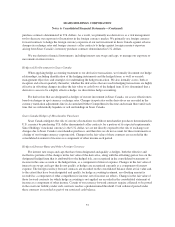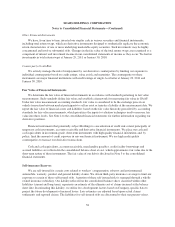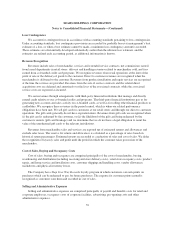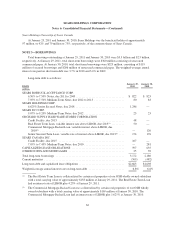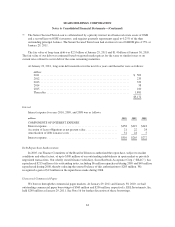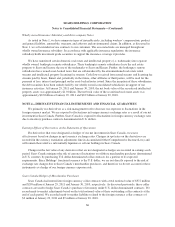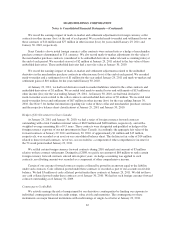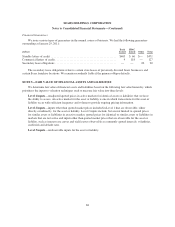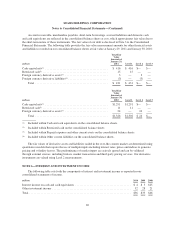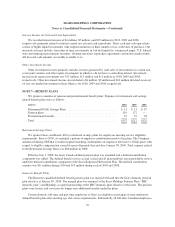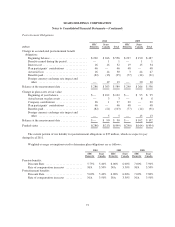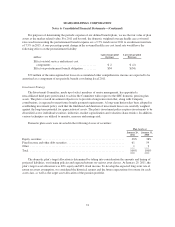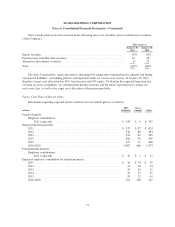Sears 2010 Annual Report Download - page 66
Download and view the complete annual report
Please find page 66 of the 2010 Sears annual report below. You can navigate through the pages in the report by either clicking on the pages listed below, or by using the keyword search tool below to find specific information within the annual report.SEARS HOLDINGS CORPORATION
Notes to Consolidated Financial Statements—(Continued)
Wholly owned Insurance Subsidiary and Inter-company Notes
As noted in Note 1, we have numerous types of insurable risks, including workers’ compensation, product
and general liability, automobile, warranty, and asbestos and environmental claims. In addition, as discussed in
Note 1, we sell extended service contracts to our customers. The associated risks are managed through our
wholly owned insurance subsidiary. In accordance with applicable insurance regulations, the insurance
subsidiary holds investment grade securities to support the insurance coverage it provides.
We have transferred certain domestic real estate and intellectual property (i.e. trademarks) into separate
wholly owned, bankruptcy remote subsidiaries. These bankruptcy remote subsidiaries lease the real estate
property to Sears and license the use of the trademarks to Sears and Kmart. Further, the bankruptcy remote
subsidiaries have issued asset-backed notes that are collateralized by the aforementioned real estate rental
streams and intellectual property licensing fee streams. Cash flows received from rental streams and licensing fee
streams paid by Sears, Kmart and, potentially in the future, other affiliates or third parties, will be used for the
payment of fees, interest and principal on the asset-backed notes issued. Since the inception of these subsidiaries,
the debt securities have been entirely held by our wholly owned consolidated subsidiaries in support of our
insurance activities. At January 29, 2011 and January 30, 2010, the net book value of the securitized intellectual
property assets was approximately $1.0 billion. The net book value of the securitized real estate assets was
approximately $0.8 billion at January 29, 2011 and $0.9 billion at January 30, 2010.
NOTE 4—DERIVATIVE FINANCIAL INSTRUMENTS AND FINANCIAL GUARANTEES
We primarily use derivatives as a risk management tool to decrease our exposure to fluctuations in the
foreign currency market. We are exposed to fluctuations in foreign currency exchange rates as a result of our net
investment in Sears Canada. Further, Sears Canada is exposed to fluctuations in foreign currency exchange rates
due to inventory purchase contracts denominated in U.S. dollars.
Earnings Effects of Derivatives on the Statements of Operations
For derivatives that were designated as hedges of our net investment in Sears Canada, we assess
effectiveness based on changes in spot currency exchange rates. Changes in spot rates on the derivatives are
recorded in the currency translation adjustments line in Accumulated Other Comprehensive Income (Loss) and
will remain there until we substantially liquidate or sell our holdings in Sears Canada.
Changes in the fair value of any derivatives that are not designated as hedges are recorded in earnings each
period. Sears Canada mitigates the risk of currency fluctuations on offshore merchandise purchases denominated
in U.S. currency by purchasing U.S. dollar denominated collar contracts for a portion of its expected
requirements. Since Holdings’ functional currency is the U.S. dollar, we are not directly exposed to the risk of
exchange rate changes due to Sears Canada’s merchandise purchases, and therefore we do not account for these
instruments as a hedge of our foreign currency exposure risk.
Sears Canada Hedges of Merchandise Purchases
Sears Canada had entered into foreign currency collar contracts with a total notional value of $372 million
and $299 million at January 29, 2011 and January 30, 2010, respectively. As discussed previously, these collar
contracts are used to hedge Sears Canada’s purchase of inventory under U.S. dollar denominated contracts. We
record mark-to-market adjustments based on the total notional value of these outstanding collar contracts at the
end of each period. We recorded mark-to-market liabilities related to the foreign currency collar contracts of
$3 million at January 29, 2011 and $9 million at January 30, 2010.
66



